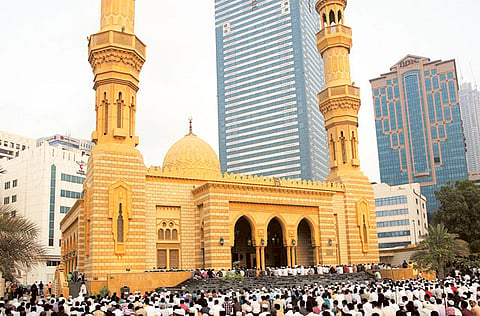New set of guidelines for mosques in Abu Dhabi
Places of worship to be within five minutes’ walk from every home in the capital

Abu Dhabi: Worshippers in Abu Dhabi will soon be no more than a five-minute walk away from the nearest mosque, as a new set of regulations requires a mosque within 350 metres of every home.
All new mosques must also include female praying areas, while public and non-residential buildings must designate space to pray for both men and women. The guidelines have been developed by the Abu Dhabi Urban Planning Council (UPC), and they aim to ensure that mosques of appropriate size with high standards for hygiene and maintenance are adequately distributed across the emirate.
“These standards, outlined within the Abu Dhabi Mosque Development Regulations guide, have been created to address the planning, design and operation of the emirate’s mosques. They will also encourage innovative design while preserving Emirati architectural heritage,” said Falah Al Ahbabi, general manager at the UPC and chairman of its Mosque Development Committee.
New mosques are expected to be constructed under these guidelines in urban areas such as Khalifa City B, Al Falah, Mohammaz Bin Zayed City and Madinat Zayed in the Western Region, Amer Al Hammadi, executive director for planning and infrastructure at the UPC, told Gulf News.
When needed, existing mosques will also be refurbished or reconstructed in line with the UPC regulations.
The newly launched UPC guide is divided into three sections. In November 2012, the first section on planning standards, which include mosque distance specifications from residential areas and size according to demographic distribution, were approved by the Abu Dhabi Executive Council.
“We decided that mosques must be 350 metres within every home as this distance can be covered in a five-minute walk, which is the shortest time between the call to prayer and the start of the prayer,” Al Hammadi explained.
The second section concentrates on design recommendations.
“For example, the areas containing toilets where worshippers can wear their shoes will be clearly distinct from the ablution area, where worshippers must remove their shoes. Ablution facilities will also be connected to the main prayer hall via a shaded corridor or lobby. Future mosques will also have a specific layout for different functional areas such as the entrance, the courtyard and the prayer hall,” Al Hammadi said.
The UPC also recommends that mosques include elements unique to Emirati architectural styles and heritage, which were determined following a recent study of UAE mosques.
“For example, there are currently many mosques which include a combination of architectural styles. What we would like to see is mosques that adhere to one cultural type, and of course we encourage greater incorporation of Emirati elements such as windtowers (barjeel),” the official added.
The final element of the guidelines focuses on efficiency in operation and maintenance. These standards will be implemented from July 2013 onwards, in collaboration with the Awqaf and Abu Dhabi General Services (Musanada), and will ensure that mosques maintain a 2-pearl rating as per the UPC’s Estidama (sustainability) requirements for public buildings.
“Wet areas must have water-saving taps. In addition, the prayer hall will be partitioned so that a small area is used for daily prayers. The entirety of the hall will only be used when worshipper volumes are bigger, such as during the Friday prayers,” Al Hammadi said.
Sign up for the Daily Briefing
Get the latest news and updates straight to your inbox



